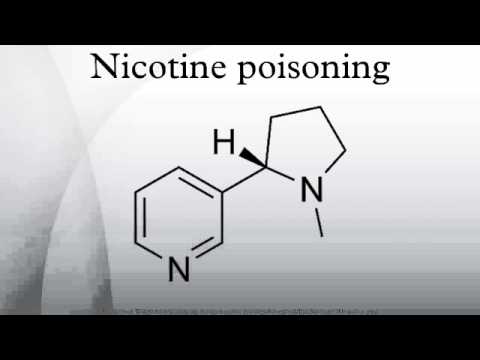Nicotine poisoning describes the symptoms of the toxic effects of consuming nicotine, which can potentially be deadly. Historically, most cases of nicotine poisoning have been the result of use of nicotine as an insecticide. More recent cases of poisoning typically appear to be in the form of Green Tobacco Sickness or due to accidental ingestion of tobacco or tobacco products or ingestion of nicotine containing plants. The estimated lower limit of a lethal dose of nicotine has been reported as between 500 and 1000 mg. Historical data as between 40 and 60 milligrams in adults and about 1 mg/kg in children . Children may become ill following ingestion of one cigarette; ingestion of more than this may cause a child to become severely ill. In some cases children have become poisoned by topical medicinal creams which contain nicotine.
People who harvest or cultivate tobacco may experience Green Tobacco Sickness, a type of nicotine poisoning caused by dermal exposure to wet tobacco leaves. This occurs most commonly in young, inexperienced tobacco harvesters who do not consume tobacco. Toxicology The LD50 of nicotine is 50 mg/kg for rats and 3 mg/kg for mice. 0.5-1.0 mg/kg can be a lethal dosage for adult humans, and 0.1 mg/kg for children. However the widely used human LD50 estimate of 0.5–1.0 mg/kg was questioned in a 2013 review, in light of several documented cases of humans surviving much higher doses; the 2013 review suggests that the lower limit causing fatal outcomes is 500–1000 mg of ingested nicotine, corresponding to 6.5–13 mg/kg orally. Nicotine therefore has a high toxicity in comparison to many other alkaloids such as Caffeine, which has an LD50 of 127 mg/kg when administered to mice.
It is unlikely that a person would overdose on nicotine through smoking alone, the US Food and Drug Administration states in 2013 “There are no significant safety concerns associated with using more than one OTC NRT at the same time, or using an OTC NRT at the same time as another nicotine-containing product—including a cigarette.” Ingestion of nicotine pharmaceuticals, tobacco products, or nicotine containing plants may also lead to poisoning. Smoking excessive amounts of tobacco has also led to poisoning; a case was reported where two brothers smoked 17 and 18 pipes of tobacco in succession and were both fatally poisoned. Spilling an extremely high concentration of nicotine onto the skin can result in intoxication or even death since nicotine readily passes into the bloodstream following skin contact. Signs and symptoms Nicotine poisoning tends to produce symptoms that follow a biphasic pattern. The initial symptoms are mainly due to stimulatory effects and include nausea and vomiting, excessive salivation, abdominal pain, pallor, sweating, hypertension, tachycardia, ataxia, tremor, headache, dizziness, muscle fasciculations, and seizures. After the initial stimulatory phase, a later period of depressor effects can occur and may include symptoms of hypotension and bradycardia, central nervous system depression, coma, muscular weakness and/or paralysis, with difficulty breathing or respiratory failure.
Pathophysiology The symptoms of nicotine poisoning are caused by excessive stimulation of nicotinic cholinergic neurons. Nicotine is an agonist at nicotinic acetylcholine receptor which are present in the central and autonomic nervous systems, and the neuromuscular junction. At low doses nicotine causes stimulatory effects on these receptors, however, higher doses or more sustained exposures can cause inhibitory effects leading to neuromuscular blockade. It is sometimes reported that people poisoned by organophosphate insecticides experience the same symptoms as nicotine poisoning. Organophosphates inhibit an enzyme called acetylcholinesterase, causing a buildup of acetylcholine, excessive stimulation of all types of cholinergic neurons, and a wide range of symptoms. Nicotine is specific for nicotinic cholinergic receptors only and has some, but not all of the symptoms of organophosphate poisoning. Diagnosis Increased nicotine or cotinine is detected in urine or blood, or serum nicotine concentrations increase. Treatment The initial treatment of nicotine poisoning may include the administration of activated charcoal to try to reduce gastrointestinal absorption.
Treatment is mainly supportive and further care can include control of seizures with the administration of a benzodiazepine, intravenous fluids for hypotension, and administration of atropine for bradycardia. Respiratory failure may necessitate respiratory support with rapid sequence induction and mechanical ventilation. Hemodialysis, hemoperfusion or other extracorporeal techniques do not remove nicotine from the blood and are therefore not useful in enhancing elimination. Acidifying the urine could theoretically enhance nicotine excretion, although this is not recommended as it may cause complications of metabolic acidosis. Prognosis The prognosis is typically good when medical care is provided and patients adequately treated are unlikely to have any long-term sequelae.
However, severely affected patients with prolonged seizures or respiratory failure may have ongoing impairments secondary to the hypoxia. It has been stated that if a patient survives nicotine poisoning during the first 4 hours, they usually recover completely. References External links How Stuff Works:Nicotine Nicotine Poisoning In Pets.
